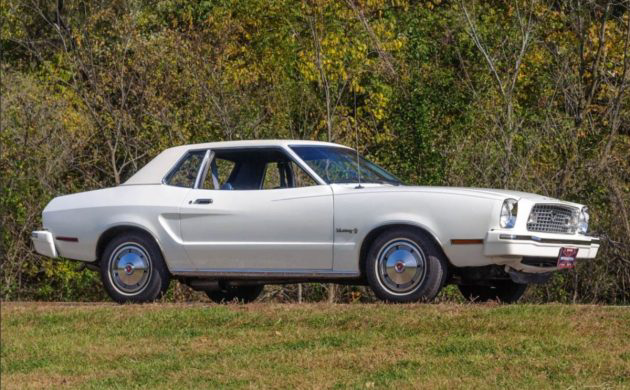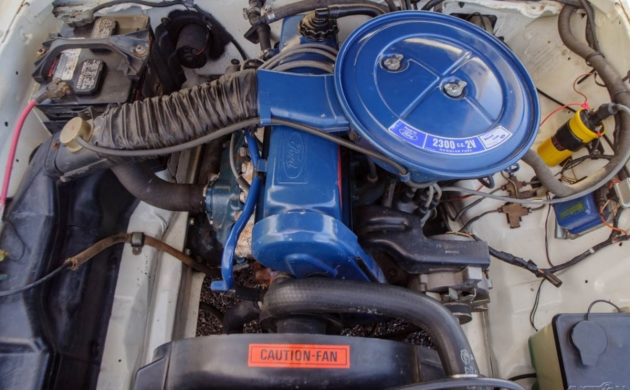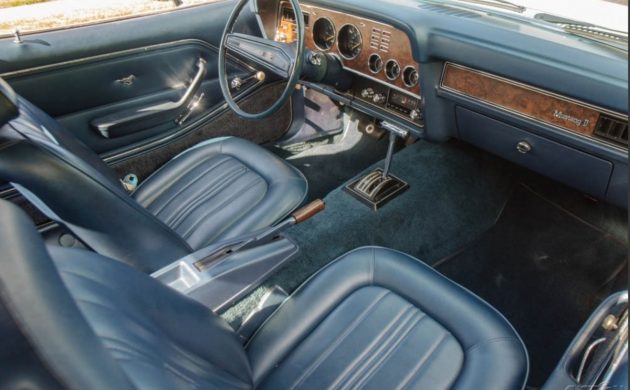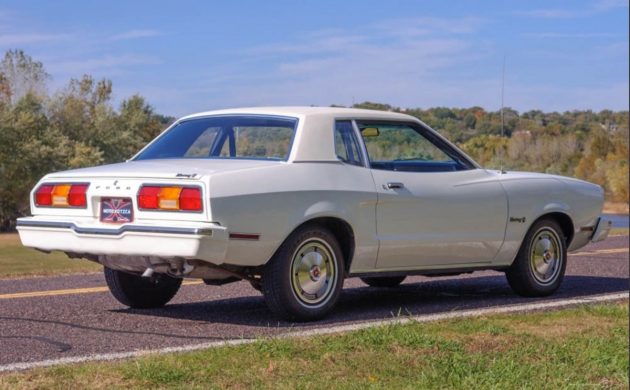The original Mustang was the right car in the right place at the right time. Therefore, it couldn’t help but be an enormous sales success that would achieve legendary status. While the 1974 Mustang II never achieved those lofty heights, it is also an example of the right car in the right place at the right time. Buyers at that time had begun to focus on smaller and more fuel-efficient vehicles, and when you park a 1973 Mustang and a ’74 Mustang II side-by-side, you gain an insight into the profound difference between the two vehicles. They have spent years being largely ignored but are finally gaining traction in the classic market. This 1974 example presents in exceptional condition for its age and appears to need nothing. The owner has decided to part with it, so he has listed it for sale here on eBay. It is located in Fenton, Missouri, and while the bidding has hit $5,500, this figure remains short of the reserve.
Some people deride the Mustang II and joke about how it looks tiny compared to its predecessor. However, running a tape measure over this car would provide some startling results. In overall length and width, the Mustang II is larger than the original Mustang and only loses out when comparing wheelbases. The “minuscule” illusion was more a perception issue, as a 1974 model does look tiny compared to a 1973 example. The reality is that the 1974 Mustang II was far closer in design philosophy to the original car than the last of those First Generation cars were. By 1973, the Mustang had morphed from lean and mean, to obese and serene. I realize that these statements are sure to ignite debate, so I’m looking forward to the feedback. Finished in vivid Pearl White, this Mustang II features a White levant vinyl top and contrasting pinstriping. Its overall presentation is well above average for a survivor of this age, and there’s no indication that any owners have performed restoration work on this classic. The paint holds an impressive shine, with few noticeable imperfections. The panels are straight, with gaps that are tight and consistent. There are no external signs of rust problems, and the underside shots show spotlessly clean floors. The bumpers and exterior trim are in excellent order, with the chrome and polished items shining impressively. With flawless glass, the overall impression that this Mustang II makes is nothing but positive.
Okay, I’ve braced myself for the collective groan that comes from performance car enthusiasts when we lift the hood of this Mustang II and find a 2.3-liter four-cylinder engine. Adding to the pain for those people, the four is backed by a three-speed automatic transmission. This combination will hardly threaten a muscle car, but it shouldn’t be underestimated. This little Mustang II should be capable of covering the ¼ mile in a neat 20 seconds. If a buyer wanted an automatic 1973 Mustang to better that number, they needed to hand over the extra cash for a V8 over the standard six. Even an entry-level 1964 Mustang with a six and auto combination could barely match that figure. I’m not making this up…honest! There’s plenty of good news for potential buyers with this little Ford. Its engine is in sound mechanical health, and somebody has treated the transmission to a recent rebuild. This included a new torque converter and flexplate, while we can add a new carburetor, fuel tank, sender unit, and tires to that list. The odometer shows a reading of 53,000 miles, and while the owner doesn’t hold verifying evidence, he believes it’s accurate. The car runs and drives extremely well and is a turnkey proposition for its next owner.
If the White exterior makes a positive impression, the Medium Blue interior continues that theme. I’m not sure if I would classify it as factory-fresh, but its overall condition is well above what you would typically find in a Mustang II of this vintage. There is no wear or physical damage on the seats, and no evidence of significant stretching. The remaining upholstered surfaces appear excellent, as do the dash, pad, and plastic components. The faux woodgrain trim has avoided the fading and lifting that can plague this type of item, and the wheel shows no evidence of significant wear. The carpet may be slightly faded and discolored, but spending $200 on a new carpet set would address this. It seems to be one of the few flaws or problems but wouldn’t require immediate attention. The interior isn’t highly equipped, but it features a complete gauge set, including a tachometer and an AM radio.
As I sit here, I can hear some enthusiasts questioning how this Mustang II could be gaining any traction in the classic market. The figures don’t lie, but it appears that it is not the older generation that likes these cars. The younger enthusiasts looking to enter the classic car ownership world see the Mustang II as an affordable option. As surprising as it may sound, the values of the Mustang II across the board have increased by an incredible 100% in the last five years. That has tapered now, but it means that a car that was virtually worthless and unwanted less than a decade ago is now a must-have item amongst some enthusiasts. This 1974 model is in exceptional condition for its age, and I won’t be surprised to see the bidding soar beyond $10,000 before the hammer falls. This auction should be worth watching.







Very good write-up Adam. Nice to see a basic low-option Mustang II which has survived in good shape. There were lots of them produced similar to this in 1974, given it was a year of high gasoline prices. I’d prefer a 4-speed to make it more fun to drive.
Yes there are plenty of people who deride the Mustang II, but they were very popular and obviously are part of decades-long Mustang production run. Despite the big production numbers, few survive today. And the nice ones which have survived are starting to bring bigger prices.
I’d take it. I can just picture Sabrina Duncan chasing the bad guys in this!
No one is chasing anyone in a 2.3litre losermobile
Kelly Garrett rocked the MII.
Sabrina had the orange Pinto. Just sayin…
Totally forgot about that. 😆
Me Like. Great for a Back and Forth work car.
Yep 99% time 3rd pedal is a plus but this seems okay automatic
If I wanted a Pinto, I’d buy a Pinto.
Awesome looking car. Although I was way too young at the time to drive a car, I remember the Mustang II. Despite criticism from haters, I’ve always loved the Mustang II. It’s been said that part of the criticism was towards its chassis and how it’s built. I’ve heard some say that it was built on a Pinto chassis, some have said that its drivetrain was that of a Pinto. I don’t know, since I was too young to drive a car. The only thing I think should’ve been done, instead of a V8 engine, a V6 engine should’ve been the engine.
I purchased a “74” in 1974. I had a four-speed with a four-cylinder engine. I believe the four-cylinder was the primary engine used in the “74” models. I don’t think V6’s were available in 1974. I never did see a 74 Mustang with a V8. I do not believe they were strongly enough built to support a V8. I only had about 20,000 miles on mine when I needed the radiator welded because of insufficient support.
My uncle had a 1974 with the 6 cylinder.
That was still underpowered, and ticked like a sewing machine. The 4 cylinder was, in my opinion, the engine to get.
Steve, Was the engine an inline-six?
Nope, I highly doubt an inline would have fit.
It was a 2.8 liter V-6, some German made engine.
I was told by someone here on a different car that these 2.8 engines were a decent engine, but I remember my uncles car being severely under powered and a really bad lifter noise. The car just sounded like garbage. Buy it lasted forever, so maybe there is some truth to what I was told. I still think the 2.3 was a better choice, just from my experiences with these and the Pintos.
When Ford came out with these things I like many others thought it was the end of the mustang and yes I know Ford was working to Fit the new government regulations to most of us we thought ford turned the mustang into a glorified pinto. In my opinion the only thing that saved this style was when the Charlie’s Angels TV series had one on the show
Before anyone states this common fallacy: A Mustang II is NOT a gussied up Pinto, a Pinto in drag, just a Pinto.. etc.
They were unique unibody cars, with next to nothing in common in their platforms. Hardpoints don’t match, subfames don’t match, firewall doesn’t match, even transmission mounting locations don’t match. The only shared components of the underlying unibody structure was the truck floor sheetmetal.
They did share FoMoCo powertrains, switchgear, and other components across the line-up. And, yes, some swap in easily, but most require modifications. They do share FoMoCo DNA, but are not same the way the 1st gens were to the Falcon, or the Fox’es were to the Fairmont.
Love the or hate them, the MII was the right car for the time, as the write up details, they were similar to the original Mustang formula, as well as the size and performance numbers in the mid-range models.
Well said Edselbill. The more I learn about them, the more I understand how they are ***not*** very closely related to the Pinto. I think people just started to assume that because of their similar size, but it’s not correct. `
It’s also interesting in hindsight to realize how the Mustang II’s formula played into the Fox Body. I.e. it too was small-ish and lighter and closer to the original formula (although with completely different styling). What a successful platform that was.
This is true however to a lay person who is not that car savvy it is a pinto under the hood it looks like a pinto engine gear selector looks like the pinto and even the dual circle gauge cluster looks like the pinto. I understand what Ford was trying to do but a lot of people were disappointed with this model of Mustang and it seems Ford is trying to kill the mustang again with this mach E thing
Edselbill, go ahead and keep the text of your post handy. You will have to post it each and every time a Mustang II is mentioned here at BF.
I had one as a winter beater. Paid $100 for it, and that was too much. Same powertrain as above. On the hills around here you would go 70mph downhill to get a run at the next hill at 45mph on the boards. Embarrassing to drive.
Many a M-II front suspension found it’s place under countless street rods . . I have one under my 1934 Chevrolet Master . . It replaced a Corvair front suspension . . . I’m pretty sure the Pinto and M-II cross member , control arms , strut rods and R&P steering are for the most part the same . .
A 1974 Mustang II as a collectible on BarnFinds? Please, somebody, shoot me.
Nice ones have been collectible for a while now Steve.
Had one only better 1977 4speed 4 cyl, int: Orange plaid seats. Changed out speedo for 120 mph car still did not not go passed 85. Only cost me the install of starter. Only problem after that was two consecutive blow outs on freeway, who said you can’t drive 85 on ten year old tires
‘In overall length and width, the Mustang II is larger than the original Mustang and only loses out when comparing wheelbases’.
The original Mustang was 181.6 inches long. The II was 175″.
The II was wider @ 70.2 ” vs 68.2
When these came out my parents bought a light blue Ghia. Beautifully trimmed.
Ford was again selling the “have it your way” appeal they used with the first Mustang.
People forget that far more mild Mustangs were sold than the muscle variety.
I remember liking the fact that Ford got back to some sort of sanity after that, yes, Adam, “obese and serene” 3/4th scale Thunderbird they sold from 71-73.
That was a lower point for the Mustang than the ’74-78.
And both parodies of the original actually.
Must be a dealer again with 36 vehicles listed, even two Lotus cars.
mustang II haters cant seem to understand that car makers have to make what people want to sell cars . In 74 people wanted a sporty car with good fuel mileage. This car did that. It took the mustang back to what it was A Sporty car. Its Shelby that made it a sports car. Imagine if Shelby made his version of the Mustang II. Plus lets not forget the front suspension was a step above that many hot rodders have used for builds over the years. The unibody build Was stronger and the suspension tauter. For me the Mustang II is a builders car like the original was. Different heads and cams. Four barrel carbs or triple deuces. Four, five or six speed tranny’s, or even crate engines. Personally i want one i can drop a 300hp 2.3 liter into. The perfect engine for this fine classic. Plus that same little 80 hp. Overhead cam 4cyl. Made 195 in the SVO and 87-88 T-bird . The 74-78 mustang helped continue the name. Maybe its time we dropped the II as we should off the Bronco II.
For everyone so down on the fact that the Mustang nameplate was used on a newly developed platform for the times…… just spend some time on google and look what happened to these great nameplates by 1978:
Baracuda
Challenger
Charger
AMX
Road Runner
GTO
… and so many more.
From 1974-78, the competition was with Toyota, Honda, VW Rabbit /Scirocco, and primarily the Chevy Monza and corp cousins.
The number one selling car of that era was often the Oldsmobile Cutlass, and the “Personal Luxury Coupe” was, by far, the category providing the most sales. Not muscle cars and not SUV’s yet.
Sure, the Camaro and Firebird soldiered on the same platform for an amazing 12 years, but the mid-entry level cars were heavy, gas guzzlers, and slow. Sure we can all talk about z-28’s and Trans-Ams of that era, but they were only marginally faster than the Cobra II. The bread and butter cars came with anemic 4’s and 6’s with auto trans.
The II was the right car for the times. (Similarly, people lament the T-bird going from the original 2 seater to the 4 seater in 1958, yet sales skyrocketed. They did the right thing.)
And, people forget this fact…. IF YOU WANTED AN ORIGINAL PLATFORM MUSTANG DURING THIS TIME, FORD WAS STILL SELLING THEM. Just by another name.
It was called the Maverick. Long in the tooth original platform of the Falcon/ Mustang, that could be had with a 302, fancy graphics, wild colors, GT packages, etc..
But, the public wanted the new, lightweight, small luxury coupe and fastback.
Sales were up 4 fold over the previous year. Sales of the II overall are only bested by the 64-66 series.
So, what did Ford do wrong? What do all the naysayers think Ford SHOULD have done? They are in the business to make money, and that they did. They are in the business to give the public what they wanted, and that they did.
There was one of these Mustang II coupes for sale 2 hours from me recently. It had an interesting paint scheme where the bottom half side of the car was painted black extending all the way up the rear quarter panel coming slightly forward above the door indentation to a point at the front part of the door. The rest of the car was red with two black race stripes on the hood. It had a rear black stand-alone spoiler which completed the look. The interior was black on red (black leather suede seats with red stripe seams, black carpet, red door panels, red dash, red pillars). Best of all it sported a 302ci and a 4 speed transmission. To me it was the best one I’ve seen by far for $5000.
I should have looked at the pictures that I had captured. The dash and pillars are actually black. Also, the steering wheel was red with a black front center which was interesting too. Anyway, it was a nice looking Mustang II.
My first car was a 74 M2 silver exterior with the same blue interior as this one. Mine had a 4 speed manual. Fun car to drive but by the time I was making enough from my paper route to make the payments mine was very tired and using a lot of oil. I didn’t care. Hand polished what was left of the faded paint and installed a JC Whitney stereo with the mandatory 6 by 9 speakers in the back. Stereo was so cheap it didn’t have a rewind feature. Had to flip the cassette tape over and use ffwd lol. I was sure proud to drive that worn out thing to school. I will admit however that it was horrible in deep snow and ice but at that time only newer vehicles way out of price range had front wheel drive much less 4wd. Thanks for the memories. If I didn’t already have way too many I’d seriously look at this one. Hope it goes to and appreciative home
Worst automotive decision I ever made. World class POS
Worst car I ever owned. The engine blew at 35K miles, but to Ford’s credit they replaced it. After that the rust started to show (which is difficult on a brown car) so I sold it and bought a 1982 Celica GT which gave me 150K maintenance-free miles.